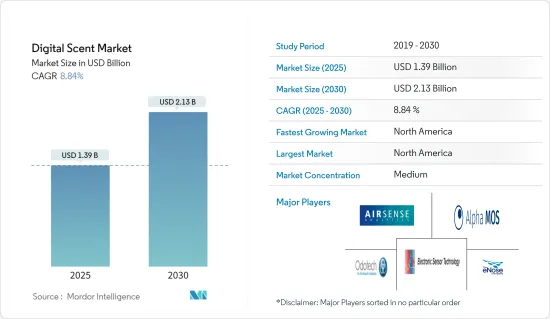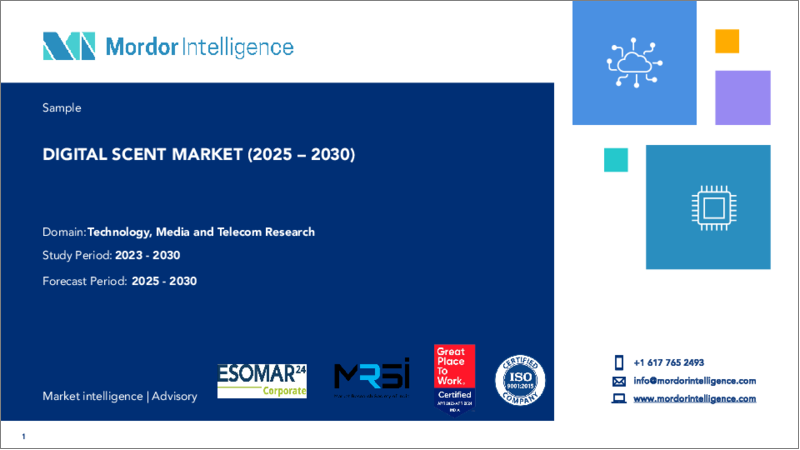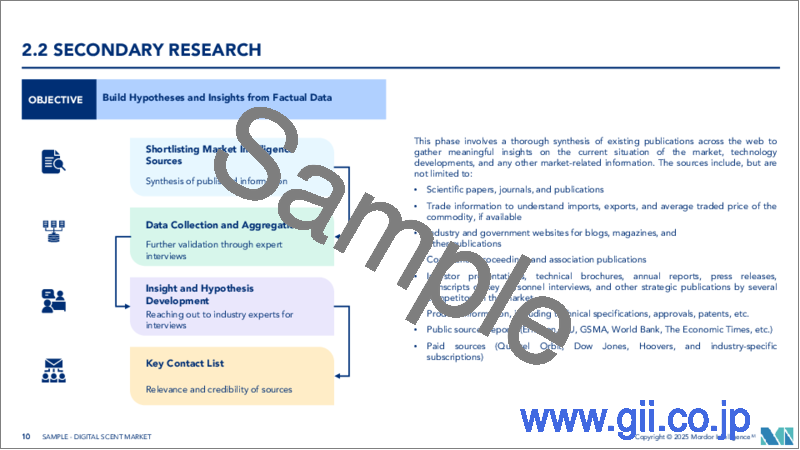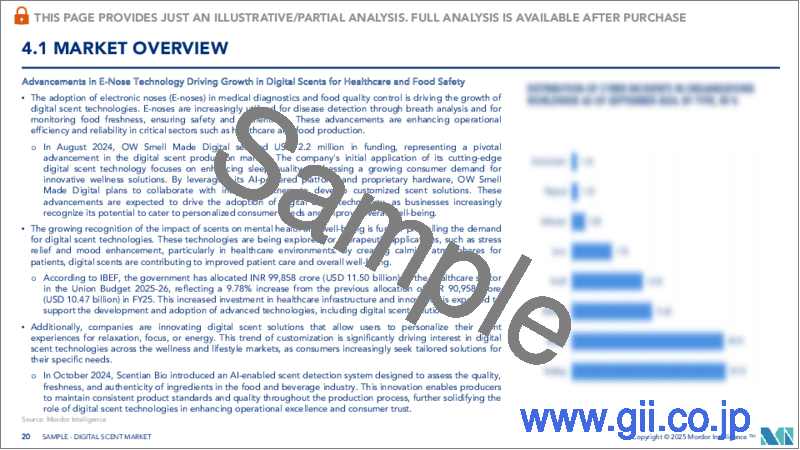|
|
市場調査レポート
商品コード
1640688
デジタル香りの市場シェア分析、産業動向・統計、成長予測(2025年~2030年)Digital Scent - Market Share Analysis, Industry Trends & Statistics, Growth Forecasts (2025 - 2030) |
||||||
カスタマイズ可能
適宜更新あり
|
|||||||
| デジタル香りの市場シェア分析、産業動向・統計、成長予測(2025年~2030年) |
|
出版日: 2025年01月05日
発行: Mordor Intelligence
ページ情報: 英文 120 Pages
納期: 2~3営業日
|
全表示
- 概要
- 目次
デジタル香りの市場規模は2025年に13億9,000万米ドルと推定され、予測期間中(2025~2030年)のCAGRは8.84%で、2030年には21億3,000万米ドルに達すると予測されます。

デジタル香り技術市場は、予測期間中に着実に拡大すると予想されるが、その主要要因は、オンラインコミュニケーションにおける香りの感覚を確立する技術の進歩にあります。現在、インターネット・コミュニケーションには、聴覚、触覚、視覚の3つの感覚が関与しています。バーチャルリアリティの概念のひとつに、デジタル臭があります。一般的に、デジタル臭はハードウェアとソフトウェア技術の組み合わせです。
主要ハイライト
- 香り産業の品質保証部門では、デジタルの香りの技術がますます使用されるようになっています。さらに、労働集約的で時間のかかる品質管理プロセスを合理化するため、拡大する世界の香りビジネスはデジタル香り技術への投資を増やし、市場の最高基準であるトップ香り産業への対応に注力しています。デジタル嗅覚センサは、特定の肌タイプや環境要因にさらされた後の香水の変化をモニターすることができます。デジタル嗅覚センサのこのような魅力的な機能により、デジタル香り技術の市場は拡大しています。
- 香水、飲食品、その他の技術を含む多くの用途において、デジタル嗅覚技術は人間の能力に大きく依存しています。警察犬でさえ、明確な匂いを検知し区別する能力には限界があります。その結果、情報の数値化と処理に時間がかかっていました。しかし、IBMやE-Nose Systemsのような企業は、AIを使って匂いをさらに処理し、分類することに成功しています。AIによって、より感度を高め、システムの能力を拡大することが可能になりました。IBMのアルゴリズムは、実験室で作られた香料や匂い付け剤を作るために必要な、労働集約的な製造手順を簡素化しました。
- 国際通信連合によると、世界人口の51%が携帯電話を使っており、約40億人がインターネットにアクセスしています。インターネットに接続可能なスマートフォンが世界中に普及しているため、研究者たちはスマートフォンに内蔵されたデジタルセント技術の搭載を拡大しています。近年、産業ではデジタルスメルの採用が見られるようになりました。研究者たちは、バーチャルリアリティによる遠距離ディスカッションの実現を目指しています。これにより、ユーザーは視覚、言語、嗅覚の真の感覚を得ることができます。こうした進歩は、世界のデジタル香技術市場に大きな影響を与えると考えられます。大手市場開拓企業はすでに、こうしたスマートフォンシステムを構築するための研究開発に投資しています。
- パンデミックと効果的に闘うためには、COVID-19のスクリーニングを迅速かつ手頃な価格で行う能力を持つことが極めて重要です。NASAはその専門知識を活かしてこの取り組みを支援しています。保健福祉省は、カリフォルニア州シリコンバレーにあるNASAのエイムズ研究センターで、特許取得済みのナノセンサとナノセンサアレイ技術を使用してCOVID-19検出用に作られたE-Noseデバイスを改良するために、NASAに380万米ドルを提供しました。NASAは、人の呼気を「嗅ぐ」ことでCOVID-19を検出するスマートフォンベースのガジェット、E-Noseを開発しています。これは以前、宇宙船内の空気の質をモニターするのに使われた技術に基づいています。
- E-nosesのデジタル化された匂いセンサ技術と香り合成技術は、信頼性の高い空気の流れによって改善されなければならないです。これらの要素がE-nosesの商品価値を下げています。これらの技術は、気流が制御され、他の環境臭が互いに干渉しない密閉空間で多用されます。このような制限により、産業ではE-nosesやその他の技術の使用が制限されています。わずかな濃度の臭気を特定し、測定することが主要課題です。においが低濃度で存在する場合、信号が大きく干渉する可能性が高くなります。
デジタル香りの市場動向
デジタル香り技術におけるAIの採用
- 人間の鼻は、無機物や有機物が発するにおい分子を利用して嗅覚を得ています。モノのエネルギーが高まると臭いが蒸発し、鼻腔から吸入・吸収されます。デジタル嗅覚も同様の働きをします。まずバイオセンサで臭いのサインを収集し、臭いのデータを分析し、ソフトウェアソリューションで結果を表示します。人工知能は、過去に収集された匂いのデータベースに基づいて、匂いのシグネチャーの解釈と分類を支援します。
- 人工知能に関する国家安全保障委員会(National Security Commission on Artificial Intelligence)によると、同委員会は最終報告書の中で、AIに対する連邦研究開発予算を毎年2倍に増やし、2026年度には総額320億米ドルにすることを議会に提案しました。バイデン政権の今年度予算案では、連邦研究開発予算は2021年度の認可水準から28%増の2,040億米ドル以上となります。新設・既設を問わず、国立AI研究機関はその資金の一部を得ることになります。このような投資は、デジタル香水技術にAIを組み込む需要を促進すると予想されます。
- さらに、スタンフォード大学によると、人工知能(AI)に対する世界の企業投資総額は2021年にほぼ940億米ドルに達し、前年から大幅に増加します。AIへの年間投資額は2018年に小幅な減少を示しました。しかし、これは一時的なものに過ぎないです。AIビジネス投資全体の大半は民間投資で占められています。
- 昨年9月、GoogleAIは人工知能を使って匂いと化学構造の相関図を作成しました。それは、物質の悪臭を表現するのに人間と同じくらい正確であり、この実験の背後にある研究者は、香りのデジタル化に向けた重要な一歩だと考えています。嗅覚の基本的な難しさは、分子構造と匂いの知覚を対応させることです。GoogleAIの研究者たちは、ニューラル・グラフ・ネットワーク(GNN)を用いて、知覚的な関連性を保持し、新規の匂い物質の匂い質の予測を可能にするプリンシパル・オドア・マップ(POM)を作成しました。
- 同様に、シンガポールの南洋理工大学(NTUシンガポール)が率いる科学者チームは、哺乳類の鼻を模倣することで、肉の鮮度を確実に評価する人工嗅覚システムを開発しました。電子鼻」(e-nose)は、肉が腐敗する際に放出するガスに反応して時間とともに色が変化する「バーコード」と、人工知能を搭載したスマートフォンアプリの形をしたバーコードリーダーで構成されています。e-noseは、バーコードの色の幅広いライブラリーから食肉の鮮度を認識・予測するよう訓練されています。
北米が主要シェアを占める見込み
- 北米は予測期間中、世界のデジタル香り市場で牽引力を増すと予想されます。RoboScientific、ALPHA MOSなどの北米のトップメーカーは、研究開発事業を通じて電子鼻の小型化を図り、顧客基盤の強化と競合優位性の獲得を目指しています。その目標は、正確な結果を出し、市場の需要に合った、携帯可能で費用対効果の高い小型の電子鼻を作ることです。これが北米の世界の電子鼻市場の拡大に拍車をかけています。
- 医療支出の増加が市場を牽引する可能性が高いです。メディケア・メディケイドサービスセンターによると、米国の医療支出は2021年に2.7%増加し、4兆3,000億米ドル、1人当たり1万2,914米ドルに達します。医療費は国内総生産(GDP)の18.3%を占めます。さらに、eNoseを使ってさまざまな疾患を診断することも可能です。ある種の疾患が内臓や代謝に影響を与え、呼気の成分を変化させることは以前から認識されています。たとえば糖尿病患者は、アセトンなどの揮発性化学化合物を比較的大量に排出します。使いやすい匂いセンサを備えたeNoseは、血糖値の測定や糖尿病設定のモニターに使用できる可能性があります。
- 市場拡大の原動力のひとつは、健康への関心の高まりです。そのため、デジタル香料の需要は、食品の品質を向上させ、ひいては食品汚染によって引き起こされる疾病の減少を助ける飲食品(F&B)事業での使用に向けて高まると予測されます。米国疾病予防管理センター(CDC)によると、年間4,800万人が食品を媒介とする感染症にかかり、3,000人が死亡しています。この電子鼻は、毒素や関連化学品の有無を検出できるセンサで構成されています。その結果、この電子鼻は食品の品質を保証するために、食品製造プロセス全体で採用されています。
- 北米地域の爆発物検知器セグメントは、軍事と防衛における広範なアプリケーションのため、予測期間中に発展すると予想されています。爆弾テロ事件の増加により、被害を抑えるために爆発物を正確かつ迅速に検出できる技術に対する大きな需要が生まれています。軍や警察は、市民を保護するために、戦闘地域や公共の場所で爆発物を識別するために爆発物探知機を採用しています。
- デジタル探知技術の最近の応用は、センサ設計の進歩、材料の改良、ソフトウェアの革新、マイクロ回路設計とシステムインテグレーションの進歩によってもたらされました。この地域の新興国市場のインフラ開拓は、ビジネスモデルを改善するために様々な産業で技術進歩の採用が増加していることと相まって、デジタル香り市場全体の成長を後押しするものと考えられます。
デジタル香り産業概要
デジタル香り市場は凝集性と結束性を併せ持つ。継続的な研究と技術の進歩が市場の主要動向となる見込みです。各社は顧客基盤を拡大し、市場での存在感を示すために様々な戦略を採用しています。主要企業としては、Alpha MOS SA、Electronic Sensor Technology Inc.、Plasmion GmbH、Odotech Inc.、The eNose Company、AIRSENSE Analytics GmbHなどが挙げられます。
- 2022年5月:生体適合性半導体の量産メーカーであるCardea Bio, Inc.は、開発途上国の感染症を迅速に診断するため、揮発性化合物を検出できるレセプターを組み込んだ高感度・高特異性のBPU(生体信号処理ユニット)アッセイを開発するため、Bill & Melinda Gates Foundationから110万米ドルの助成金を授与されたと発表しました。この研究は、昆虫臭覚受容体[iOR]で機能化されたカルデアBPUがアゴニスト臭覚物質を検出できるかどうかを確認することを目的としています。
- 2022年6月:Firmenichは、中国の杭州を拠点とするデジタル香り技術のパイオニアであるScentRealmとの戦略的提携を発表しました。この提携は中国初のもので、香りビジネスと感覚エクスペリエンスエクスプローラーの専門知識を結びつけるものです。これにより、開発されたデジタル機器を活用し、香りのデジタルの未来を調査することで、Firmenichは顧客と消費者の香りと嗅覚体験を向上させることができます。Firmenichは、産業初のAIを拡大したランドリーケア用香りや、AI技術と人間の創造性を融合させたAIによる初のフレーバーを発表するなど、デジタル変革の最前線にいます。
その他の特典
- エクセル形式の市場予測(ME)シート
- 3ヶ月間のアナリストサポート
目次
第1章 イントロダクション
- 調査の成果
- 調査の前提
- 調査範囲
第2章 調査手法
第3章 エグゼクティブサマリー
第4章 市場力学
- 市場概要
- 市場促進要因と市場抑制要因の採用
- 市場促進要因
- デジタル香り技術におけるAIの採用
- 市場抑制要因
- 電子鼻の初期コストの高さ
- 産業バリューチェーン分析
- 産業の魅力-ポーターのファイブフォース分析
- 買い手/消費者の交渉力
- 供給企業の交渉力
- 新規参入業者の脅威
- 代替品の脅威
- 競争企業間の敵対関係の強さ
第5章 市場セグメンテーション
- ハードウェア別
- 香り合成装置
- 電子鼻
- エンドユーザー産業別
- 軍事・防衛
- 医療
- 飲食品
- 廃棄物管理(環境モニタリング)
- その他
- 地域
- 北米
- 欧州
- アジア太平洋
- その他
第6章 競合情勢
- 企業プロファイル
- Alpha MOS SA
- Electronic Sensor Technology
- Plasmion GmbH
- Odotech Inc.
- The eNose Company
- Airsense Analytics GmbH
- Aryballe Technologies SA
- Comon Invent BV
第7章 投資分析
第8章 市場機会と今後の動向
The Digital Scent Market size is estimated at USD 1.39 billion in 2025, and is expected to reach USD 2.13 billion by 2030, at a CAGR of 8.84% during the forecast period (2025-2030).

The Digital Scent Technology Market is expected to increase steadily over the forecast period, owing mostly to technological advances for establishing a sense of scent in online communication. Currently, three senses are involved in internet communication: hearing, touching, and sight. One of the notions of virtual reality is the digital smell. In general, the digital smell is a combination of hardware and software technology.
Key Highlights
- In the quality assurance division of the fragrance industry, digital scent technology has been used more and more. Further, to streamline the labor-intensive and time-consuming quality control process, the expanding global fragrance business is investing more and more in digital scent technology and focusing on meeting the market's highest criteria, the top fragrance industries. Digital olfactory sensors can monitor changes in perfume after exposure to specific skin types or environmental factors. The market for digital scent technology has expanded due to these appealing features of digital noses.
- In many applications, including those involving perfumes, food and beverages, and other technologies, digital scent technology is highly dependent on human ability. Even police dogs have limited ability to detect and distinguish between distinct odors. The information took time to quantify and process as a result. However, businesses like IBM and E-Nose Systems have successfully used AI to process further and categorize the scents. With AI, it is now possible to gain more sensitivity and expand the system's capabilities. IBM's algorithm has simplified the labor-intensive manufacturing procedure needed to make lab-made fragrances and odorants.
- According to the International Telecommunication Union, 51% of the global population uses mobile-cellular devices, with around 4 billion having internet access. Researchers have been expanding the installation of Digital Scent Technology in-built into smartphones due to the widespread availability of smartphones with internet connectivity worldwide. In recent years, the industry has seen the introduction of Digital Smell. Researchers hope to create virtual-reality long-distance discussions. This will give users a true sensation of sight, speech, and smell. These advancements will significantly impact the global Digital Scent Technology Market. Major market players have already invested in research and development to build these smartphone systems.
- In order to effectively combat the pandemic, it is crucial to have the ability to swiftly and affordably screen people for COVID-19. NASA is using its expertise to aid with this effort. The Department of Health and Human Services has provided NASA with USD 3.8 million to improve the E-Nose device created at NASA's Ames Research Center in California's Silicon Valley using patented nanosensors and nanosensor array technology for COVID-19 detection. NASA is developing E-Nose, a smartphone-based gadget, to detect COVID-19 by "sniffing" a person's breath. It is based on technology previously used to help monitor air quality inside spacecraft.
- The digitalized smell sensor technology of the E-noses and the scent synthesizer technologies must be improved by reliable airflow. These elements have decreased the E-noses' product value. These technologies are heavily used in enclosed spaces where the airflow is controlled, and other environmental odors don't interfere with one another. These limitations have limited the industry's use of E-noses and other technologies. Identifying and measuring the odor in the little concentration is the main challenge. There is a larger likelihood of significant signal interference when an odor is present in low concentrations.
Digital Scent Market Trends
Introduction of AI in Digital Scent Technology
- The human nose employs odor molecules emitted by inorganic and organic things to enable the sense of smell. When the energy in things increases, the odor evaporates, allowing them to be inhaled and absorbed through the nasal cavity. Digital olfaction functions similarly. It first gathers odor signatures with biosensors, analyzes the odor data, and displays the results with software solutions. Artificial intelligence helps interpret the signatures and classify them based on a database of previously collected smells.
- According to National Security Commission on Artificial Intelligence, In its final report, it proposed Congress increase federal R&D funding for AI by a factor of two annually, up to a total of USD32 billion in fiscal 2026. The federal R&D budget will be increased by 28% from FY 2021 authorized levels to more than USD 204 billion under the Biden administration's fiscal of this year budget plan. The National AI Research Institutes, both new and established, would get some of that funds. Such investments are expected to drive the demand for incorporating AI in digital scent technology.
- Further, according to Stanford University, global total business investment in artificial intelligence (AI) will reach almost USD 94 billion in 2021, a considerable rise from the previous year. The annual investment in AI showed a modest decrease in 2018. However, this was only temporary. The majority of overall AI business investment is made up of private investments.
- In September last year, Google AI used artificial intelligence to create a map correlating odors to chemical structures. It is as accurate as a human in describing a substance's stench, and the researchers behind the experiment think it is an important step toward digitizing scents. A fundamental difficulty in olfaction is mapping molecular structure to odor perception. The Google AI researchers create a Principal Odor Map (POM) that preserves perceptual associations and enables odor quality prediction for novel odorants using neural graph networks (GNN).
- Similarly, a team of scientists led by Nanyang Technological University, Singapore (NTU Singapore) has developed an artificial scent system that reliably assesses the freshness of meat by mimicking the mammalian nose. The 'electronic nose' (e-nose) consists of a 'barcode' that changes color over time in response to the gases released by meat as it decays and a barcode reader in the form of an artificial intelligence-powered smartphone app. The e-nose has been trained to recognize and predict meat freshness from a wide library of barcode colors.
North America is Expected to Hold Major Share
- North America is expected to gain traction in the global digital scent market during the projected period. Top North American manufacturers such as RoboScientific, ALPHA MOS, and others are aiming to reduce the size of electronic noses through research and development (R&D) operations to boost their client base and gain a competitive advantage. The goal is to create a portable, cost-effective, and tiny electronic nose that can produce accurate results and suit market demands. This is fueling the expansion of North America's worldwide electronic nose market.
- The increase in healthcare spending is likely to drive the market. According to the Centers for Medicare and Medicaid Services, U.S. healthcare spending would increase by 2.7% in 2021, reaching USD 4.3 trillion, or USD 12,914 per person. Health spending accounted for 18.3%of the nation's GDP. Further, it is also possible to use eNose to diagnose various disorders. It has long been recognized that certain diseases affect internal organs or metabolism and alter the composition of exhaled air. Diabetes patients, for example, expel comparatively large amounts of volatile chemical compounds such as acetone. The eNose, which comes with an easy-to-use smell sensor, could be used to determine blood sugar levels and monitor diabetes settings.
- One of the driving factors for market expansion is the growing health concern. Thus, demand for digital scents is predicted to rise for usage in the food and beverage (F&B) business to improve food quality, which in turn aids in the reduction of diseases caused by food contamination. According to the Centers for Disease Control and Prevention (CDC), 48 million people get sick from food-borne infections yearly, with 3,000 dying. This electronic nose comprises sensors that can detect the presence or absence of toxins and associated chemicals. As a result, this electronic nose is employed throughout the food manufacturing process to ensure food quality.
- The explosive detectors segment in the North America region is expected to develop during the forecast period due to its extensive application in military and defense. The growing number of terrorist bombings has produced a significant demand for technologies that can detect explosives accurately and swiftly to limit damage. The military and police employ explosive detectors to identify explosives in combat zones and public locations in order to protect citizens.
- The recent applications of digital scent technologies have come through advancements in sensor design, material improvements, software innovations, and progress in microcircuitry design and systems integration. The developing infrastructure in the region, coupled with the rising adoption of technological advancements across various industries to better the business model, is set to boost the growth of the overall digital scent market.
Digital Scent Industry Overview
The digital scent market is both cohesive and cohesive. Ongoing research and technological advancements are expected to be the key trends in the market. The companies are adopting various strategies to expand their customer base and mark their presence in the market. Some key players are Alpha MOS SA, Electronic Sensor Technology Inc., Plasmion GmbH, Odotech Inc., The eNose Company, and AIRSENSE Analytics GmbH, among others.
- May 2022: Cardea Bio, Inc., the mass producer of biocompatible semiconductors, announced that the Bill & Melinda Gates Foundation had awarded it a USD 1.1 million grant to develop a BPU (Biosignal Processing Unit) assay with high sensitivity and specificity that incorporates receptors capable of detecting volatile compounds to diagnose infectious diseases in developing countries rapidly. This study aims to see if Cardea BPUs functionalized with an insect Odorant Receptor [iOR] can detect an agonist odorant.
- June 2022: Firmenich has announced a strategic alliance with ScentRealm, a pioneer in digital scent technology based in Hangzhou, China. This relationship is the first of its type in China, bringing together the expertise of a fragrance business and a sense experience explorer. It will allow Firmenich to improve the fragrance and olfactory experience for its clients and consumers by utilizing developed digital devices and investigating the digital future of scent. Firmenich is at the forefront of digital transformation, having introduced the industry's first AI-augmented laundry care fragrances and the first flavor created by AI by merging AI technology with human creativity.
Additional Benefits:
- The market estimate (ME) sheet in Excel format
- 3 months of analyst support
TABLE OF CONTENTS
1 INTRODUCTION
- 1.1 Study Deliverables
- 1.2 Study Assumptions
- 1.3 Scope of the Study
2 RESEARCH METHODOLOGY
3 EXECUTIVE SUMMARY
4 MARKET DYNAMICS
- 4.1 Market Overview
- 4.2 Introduction to Market Drivers and Restraints
- 4.3 Market Drivers
- 4.3.1 Introduction of AI in Digital Scent Technology
- 4.4 Market Restraints
- 4.4.1 High Initial Cost of Electronic Noses
- 4.5 Industry Value Chain Analysis
- 4.6 Industry Attractiveness - Porter's Five Force Analysis
- 4.6.1 Bargaining Power of Buyers/Consumers
- 4.6.2 Bargaining Power of Suppliers
- 4.6.3 Threat of New Entrants
- 4.6.4 Threat of Substitute Products
- 4.6.5 Intensity of Competitive Rivalry
5 MARKET SEGMENTATION
- 5.1 By Hardware
- 5.1.1 Scent Synthesizer
- 5.1.2 E-Nose
- 5.2 By End-user Industry
- 5.2.1 Military and Defense
- 5.2.2 Healthcare
- 5.2.3 Food and Beverage
- 5.2.4 Waste Management (Environmental Monitoring)
- 5.2.5 Other End-user Industries
- 5.3 Geography
- 5.3.1 North America
- 5.3.2 Europe
- 5.3.3 Asia Pacific
- 5.3.4 Rest of the World
6 COMPETITIVE LANDSCAPE
- 6.1 Company Profiles
- 6.1.1 Alpha MOS SA
- 6.1.2 Electronic Sensor Technology
- 6.1.3 Plasmion GmbH
- 6.1.4 Odotech Inc.
- 6.1.5 The eNose Company
- 6.1.6 Airsense Analytics GmbH
- 6.1.7 Aryballe Technologies SA
- 6.1.8 Comon Invent BV






